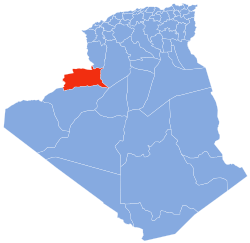
Tabelbala is a town and commune between Béchar and Tindouf in south-western Algeria, and is the capital, and only significant settlement, of the Daïra of the same name, encompassing most of the western half of Béni Abbès Province. As of the 2008 census, its population was 5,121, up from 4,663 in 1998, with an annual growth rate of 1.0%. The commune covers an area of 60,560 square kilometres (23,380 sq mi), making it by far the largest commune in the province, as well as the least densely populated.
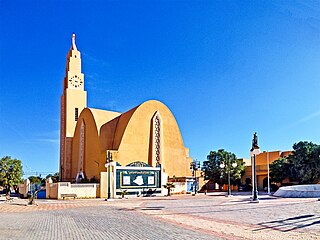
Béchar is the capital city of Béchar Province, Algeria. It is also a commune, coextensive with Béchar District, of Béchar Province. In 2008 the city had a population of 165,627, up from 134,954 in 1998, with an annual growth rate of 2.1%. The commune covers an area of 5,050 square kilometres (1,950 sq mi).
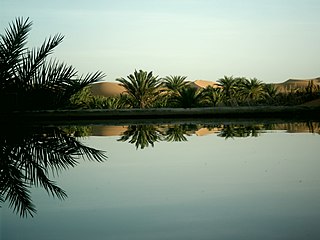
Igli is a town and commune in Béchar Province, western Algeria, located 152 km south of Bechar. It is coextensive with Igli District. Its population was 6,682 as of the 2008 census, up from 5,474 in 1998, and an annual population growth rate of 2.1%. The commune covers an area of 6,220 square kilometres (2,400 sq mi).
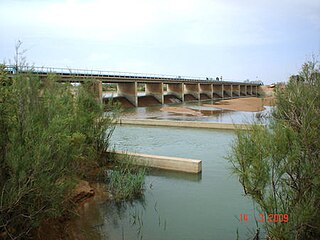
Abadla is a town and commune in western Algeria, and capital of Abadla District, Béchar Province. It is located on the Oued Guir southwest of Béchar. According to the 2008 census its population is 13,636, up from 10,845 in 1998, and an annual growth rate of 2.4%, making it the most populated commune in Béchar Province apart from the capital. The commune covers an area of 2,870 square kilometres (1,110 sq mi).

Béni Abbès, also known as the Pearl of the Saoura, and also as the White Oasis, is a town and commune located in western Algeria in Béchar Province, 241 km (150 mi) far from the provincial capital Béchar, and 1,200 km (746 mi) from Algiers.

Béni Ikhlef is a town and commune in Kerzaz District, Béchar Province, in western Algeria. As of the 2008 census, its population was 2,459, up from 2,280 in 1998, with an annual growth rate of 0.8%. The commune covers an area of 2,617 square kilometres (1,010 sq mi).

Boukaïs is a town and commune in Lahmar District, Béchar Province, in western Algeria. According to the 2008 census its population is 970, up from 890 in 1998, and its annual population growth rate is 0.9%. The commune covers an area of 1,760 square kilometres (680 sq mi).

El Ouata is a town and commune in Béchar Province, western Algeria. The commune is coextensive with El Ouata District, which is named after the town. According to the 2008 census its population is 7,343, up from 7,014 in 1998, with an annual population growth rate of 0.5%. The commune covers an area of 2,870 square kilometres (1,110 sq mi).

Erg Ferradj is a town and commune in Abadla District, Béchar Province, in western Algeria. According to the 2008 census its population is 4,406, down from 4,670 in 1998, and an annual population growth rate of -0.6%, the second lowest in the province. The commune covers an area of 6,410 square kilometres (2,470 sq mi).

Kerzaz is a town and commune, and capital of Kerzaz District, in Béchar Province, western Algeria. According to the 2008 census its population is 5,028, up from 4,276 in 1998, and its annual growth rate is 1.7%. The commune covers an area of 10,520 square kilometres (4,060 sq mi).
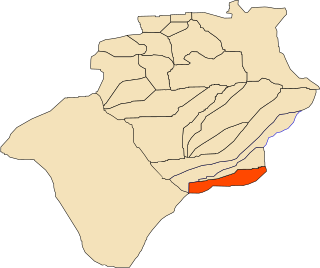
Ksabi is a town and commune in Ouled Khodeïr District, Béchar Province, in western Algeria. According to the 2008 census its population is 3,187, up from 2,656 in 1998, with an annual growth rate of 1.9%. The commune covers an area of 2,220 square kilometres (860 sq mi).

Méchraâ Houari Boumédienne is a town and commune in Abadla District, Béchar Province, in western Algeria. According to the 2008 census its population is 3,091, down from 3,133 in 1998, with an annual growth rate of -0.1%. The commune covers an area of 2,820 square kilometres (1,090 sq mi).
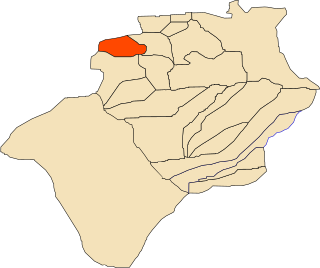
Méridja is a town and commune in Kénadsa District, Béchar Province, in western Algeria. As of 2008 the population of the commune was 592, up from 532 in 1998, with an annual growth rate of 1.1%. This makes it the smallest commune by population in Béchar Province. The commune covers an area of 2,270 square kilometres (880 sq mi).

Mogheul is a town and commune in Lahmar District, Béchar Province, in western Algeria near the border with Morocco. According to the 2008 census its population is 635, down from 682 in 1998, with an annual growth rate of -0.7%, the lowest in the province. The commune covers an area of 640 square kilometres (250 sq mi), making it the smallest by area in the province.
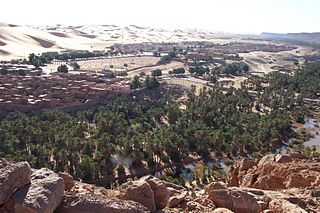
Taghit is a town and commune in Taghit District, Béchar Province, in western Algeria. The town is an oasis watered by the underground Oued Zousfana, which runs along beside the dunes of the Grand Erg Occidental. According to the 2008 census its population is 6,317, up from 6,047 in 1998, with an annual growth rate of 0.4%. The commune covers an area of 8,080 square kilometres (3,120 sq mi).

Tamtert, also written Tamert or Tamatart is a town and commune in Béni Abbès District, Béni Abbès Province, in western Algeria. According to the 2008 census its population is 1,248, down from 1,302 in 1998, with an annual growth rate of -0.4%. The commune covers an area of 3,130 square kilometres (1,210 sq mi).

Timoudi is a town and commune in Kerzaz District, Béchar Province, in western Algeria. According to the 2008 census its population is 2,389, up from 2,116 in 1998, with an annual population growth rate of 1.2%. The area of the commune is 6,175 square kilometres (2,384 sq mi).

Ouled Khoudir is a town and commune in Ouled Khoudir District, Béchar Province, in western Algeria. According to the 2008 census its population is 4,251, up from 3,893 in 1998, with an annual growth rate of 0.9%. The commune covers an area of 1,920 square kilometres (740 sq mi).
Zoubia is a village in south-western Algeria. It is part of the commune of Béni Ounif, in Béchar Province, Algeria, and is 25 kilometres (16 mi) northeast of the town of Béni Ounif.
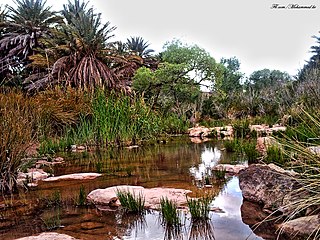
Fendi is a village in the commune of Béni Ounif, in Béni Ounif District, Béchar Province, Algeria. The village is located next to a wadi at the end of a local road leading south from its intersection with the N6 highway west of Béni Ounif. It is 75 kilometres (47 mi) east of Béchar and 32 kilometres (20 mi) southwest of Béni Ounif.





















